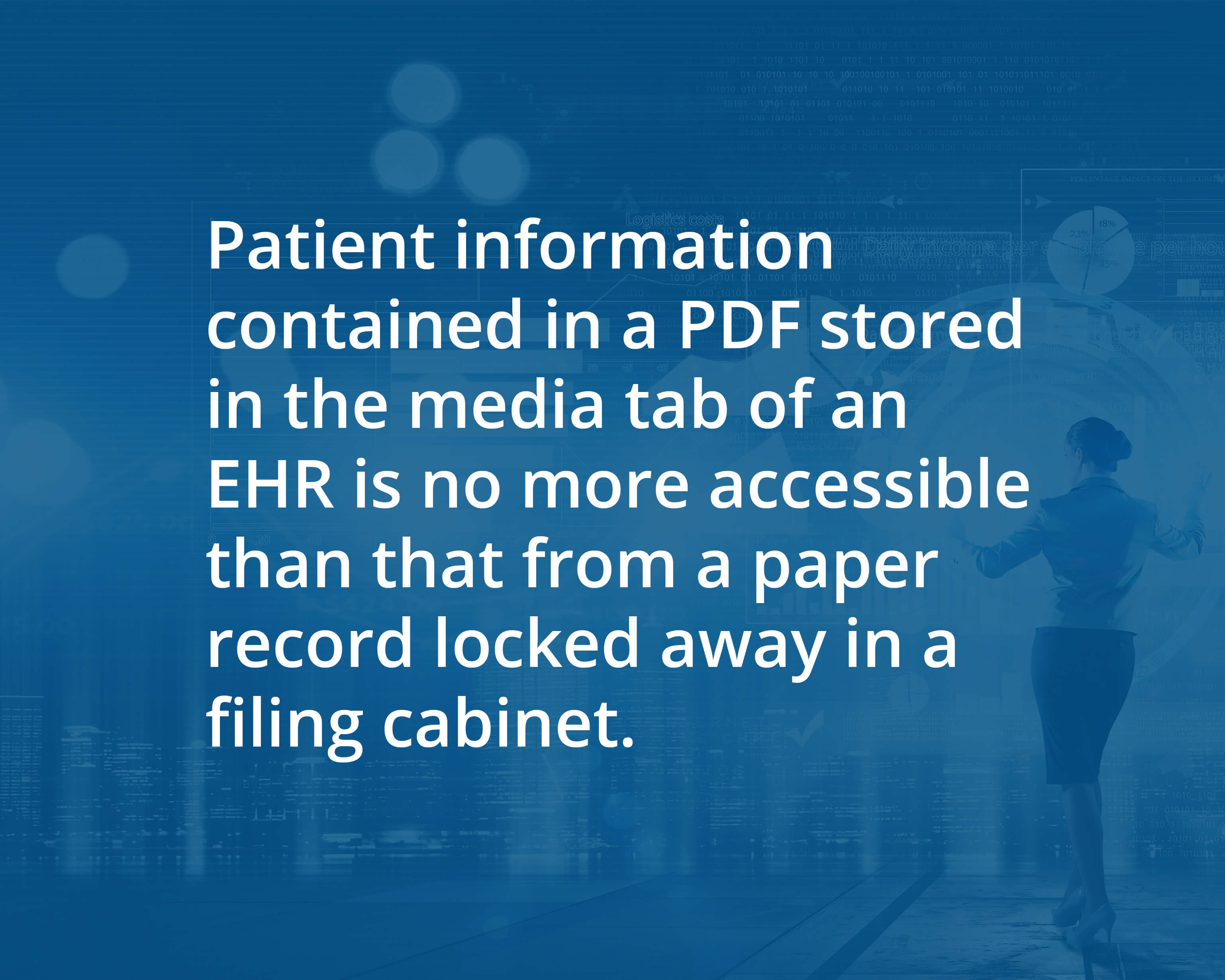Solution or Problem? Has the PDF Outlived Its Usefulness in Health Information Management?
The time has come to make the EHR smarter by allowing access to fully integrated and curated patient data that is readily accessible and searchable. It is only when we have completely interoperable systems with data analytics capabilities and no data locked away in PDFs that we will realize the full potential of electronic health information systems.
How PDFs Became a Standard for Sharing Health Information
The portable document format or PDF was the creation of the Adobe corporation in the early 1990s. The intended goal of the PDF was “to enable anyone to capture documents from any application, send electronic versions of these documents anywhere, and view and print them on any machine.”1 (With that goal in mind, the PDF has become the undisputed leading format, and global standard for the reliable transfer of electronic documents. Modern documents exist in numerous formats including paper, film, and electronically within computer systems. Documentation is necessary for presenting information and/or evidence and serves as an official record. Thus, it is not surprising that electronic health records (EHR) adopted the use of PDFs as a means of sharing and storing patient information from various applications and information systems especially when the information was generated outside of the closed enterprise EHR network.
The US health information industry began in the 1920s “when health care professionals realized that documenting patient care benefited both providers and patients.”2 Early patient records were written on paper and included details about patient care, complications, and outcomes. Paper records continued well into the 1960s and 70s, and it was not until the 80s and 90s that computer technology was adopted, starting with a handful of forward-thinking health services departments such as radiology and laboratory services. Health system-wide information platforms did not appear until years later and to this day, those system-wide platforms are not fully integrated (or interoperable) with other more specialized systems that are used to manage data within the medical subspecialties. As a result, PDFs became the logical vehicle for electronically sharing patient information (reports) between medical subspecialties and treating clinicians whose primary electronic platform was the enterprise EHR system.
The Call for Adoption of Electronic Health Records
Electronic medical record (EMR) systems were developed to address the day-to-day operations and common needs of providers (scheduling, billing, ordering) as well as taking patient charts from paper to a digital format. The evolution of the EMR allowed for storing data for a patient across time with a focus on care management, improvement of outcomes and population health.3 The advantages of using digital formats for designing workflows, creating and storing documents, and having the ability to search retrospective data became quickly apparent. Also, during this time, an increasing number of students were entering the fields of computer and data science and knowledge engineering so that an increasing number of skilled workers were also becoming more available.

In 2004 President George W. Bush called for the computerization of health records4, and in 2009 President Barrack Obama promised support for the adoption of electronic health records by 2014.5 Under President Bush, the Office of the National Coordinator for Health Information Technology (ONC) was established to promote the creation of a national health information technology infrastructure and to assist healthcare providers to convert from paper to electronic health record keeping.6
When Will We Realize the Full Potential of Electronic Health Records?
While the country’s EHRs have made impressive progress in the computerization of health information, the systems have not yet reached their full potential due to a lack of interoperability with other medical subspecialty systems such as radiology and laboratory information systems, revenue cycle management and other healthcare-related systems. Data from these systems continues to be siloed. The limitations of siloed data on our ability to improve patient care, attain new knowledge of disease insights, and demonstrate value-based care have long been recognized. The continued use of PDFs as a medium for sharing patient information is a band-aid solution to overcoming this lack of interoperability. Patient information contained in a PDF stored in the media tab of an EHR is no more accessible than that from a paper record locked away in a filing cabinet. There is no technological reason why these systems could not be completely interoperable. The complete interoperability of health information technology continues to be a primary goal of the ONC.
Healthcare providers today are faced with an exponentially increasing volume, variety and complexity of data to be considered for optimizing treatment plans for patients. While some of this data is readily accessible within the data fields of the EHR, much of it, particularly biomarker results that are increasingly used to guide targeted therapies are not. These results are often shared via PDF reports and stored in the media tab. Thus, the data is neither readily accessible nor searchable. Informatics solutions such as XIFIN’s VisualStrata platform augments the EHR’s capabilities by seamlessly connecting to the data at its source and structuring it so that it is readily accessible and searchable. The time has come to make the EHR smarter by allowing access to fully integrated and curated patient data. Only completely interoperable systems with data analytics capabilities that have no data locked away in PDFs will we realize the full potential of electronic health information management systems.
Sources:
1. https://acrobat.adobe.com/us/en/acrobat/about-adobe-pdf.html
2. https://www.rasmussen.edu/degrees/health-sciences/blog/health-information-management-history/
3. https://www.thejournalofprecisionmedicine.com/december-2019/
4. https://georgewbush-whitehouse.archives.gov/infocus/technology/economic_policy200404/chap3.html
5. https://www.ncbi.nlm.nih.gov/pmc/articles/PMC2871223/pdf/182e315.pdf
6. https://searchhealthit.techtarget.com/definition/ONC
Published by XIFIN

